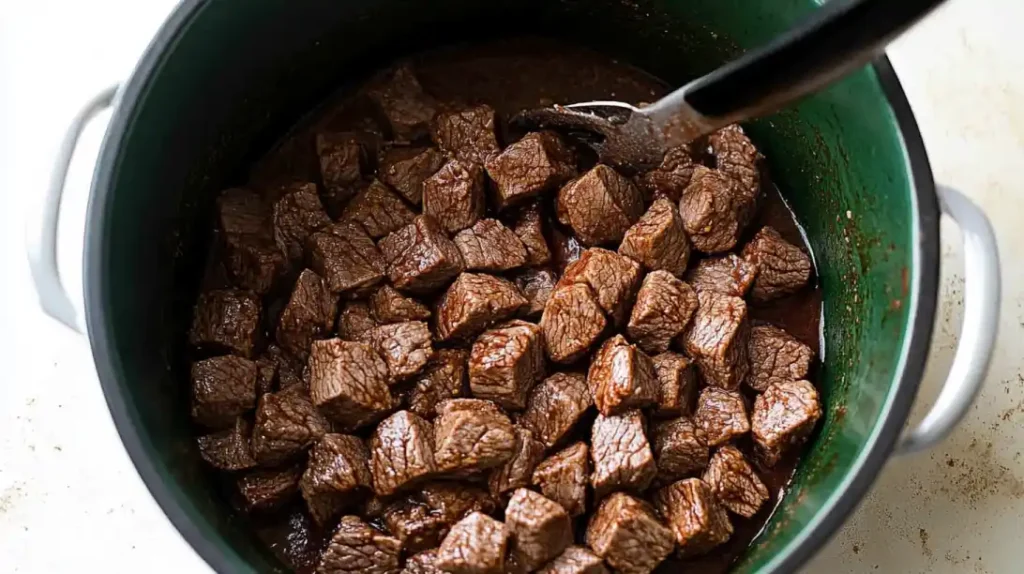The Best Fluffy Pancakes recipe you will fall in love with. Full of tips and tricks to help you make the best pancakes.

Carne en su Jugo, or “Meat in its Juices,” is a flavor-packed Mexican dish originating from the state of Jalisco. This rich, comforting stew features tender beef, smoky bacon, creamy pinto beans, and a tangy tomatillo broth, all coming together in one pot for a meal that is bursting with traditional flavors.
If you’re looking for an authentic Carne en su Jugo recipe that stays true to its roots while adding a unique twist, you’re in the right place. This guide will walk you through:
✔️ How to make Carne en su Jugo step by step
✔️ The best cuts of meat to use for maximum tenderness
✔️ Pro tips to enhance flavor and texture
✔️ How to store and reheat leftovers without losing quality
✔️ Perfect side dishes and toppings to serve with this classic dish
By the end, you’ll be a Carne en su Jugo expert, ready to impress your family with this soul-warming, restaurant-quality dish. Let’s get started!
Table of Contents
📌 What Is Carne en su Jugo?
Carne en su Jugo literally translates to “Meat in its Juices.” It’s a hearty Mexican stew made by simmering bite-sized pieces of beef in their own juices, along with bacon, pinto beans, and a bright tomatillo-based broth. The result? A deeply flavorful dish with layers of smokiness, tanginess, and umami-rich beefiness.

Where Did Carne en su Jugo Originate?
This dish hails from Jalisco, Mexico, the same region famous for Birria, Tortas Ahogadas, and Tequila. While less famous than these dishes, Carne en su Jugo is a hidden gem of Jalisco’s cuisine—one that every Mexican food lover should try.
🔗 Want more Mexican flavors? Check out: Salsa Roja Recipe Guide
🍖 Best Cut of Meat for Carne en su Jugo
Choosing the right cut of beef is essential for the perfect texture.
🥩 Top Recommended Cuts:
✔ Top Sirloin – Lean, tender, and perfect for quick cooking.
✔ Beef Strip Steak – A flavorful cut that works well in stews.
✔ Top Round – Affordable and great for bite-sized pieces.
✔ Chuck Roast – Adds more fat and richness but takes longer to cook.
Pro Tip: Cut the meat into small, bite-sized pieces for faster cooking and better flavor infusion!
🔗 More beef cooking tips: What Is Meat Served with Its Own Juices?
🔥 How to Make Carne en su Jugo (Step by Step)
Follow these simple steps to achieve a restaurant-quality Carne en su Jugo at home.
🛒 Ingredients:
- 12 oz bacon, chopped
- 2 ½ lbs beef sirloin, cut into small pieces
- 3 tsp kosher salt, divided
- 6 tomatillos, husked and rinsed
- 3 serrano peppers, stemmed and seeded (for heat, keep the seeds!)
- 1 cup cilantro, chopped (divided)
- 3 cloves garlic, minced
- ½ tsp ground cumin
- ½ tsp black pepper
- 3 cups water
- 2 (15-oz) cans pinto beans, drained and rinsed
- Toppings: Chopped white onion, cilantro, radishes, lime wedges

👨🍳 Step 1: Cook the Bacon
In a large Dutch oven or deep pot, cook the chopped bacon over medium heat until crispy (about 10 minutes). Remove and set aside, leaving the bacon fat in the pot.

🔥 Step 2: Brown the Beef
- Season the beef pieces with 1 tsp kosher salt.
- Add the beef to the pot with the bacon fat and cook until browned on all sides (about 10 minutes).
- Remove and set aside.

🌿 Step 3: Make the Tomatillo Sauce
While the beef browns, blend together:
✔ Tomatillos
✔ Serrano peppers
✔ ½ cup cilantro
✔ Garlic, cumin, black pepper, and 2 tsp salt
✔ 3 cups water
Blend until smooth.
🍲 Step 4: Simmer Everything Together
- Pour the tomatillo sauce into the pot.
- Add the browned beef back in.
- Bring to a boil, then reduce to a simmer for 30-35 minutes.
🥣 Step 5: Add the Pinto Beans
- Stir in the pinto beans and let them heat for 2 more minutes.

🍽️ Step 6: Serve & Garnish
Ladle into bowls and top with:
✔ Crispy bacon
✔ Diced onions
✔ Chopped cilantro
✔ Radish slices
✔ Fresh lime juice
🔗 More meal ideas: Mastering Easy Dinner Recipes

🌮 Best Side Dishes to Serve with Carne en su Jugo
Want to make your meal even better? Serve it with:
✔ Warm Corn Tortillas – Perfect for soaking up the broth.
✔ Mexican Rice – Adds extra heartiness.
✔ Chicharrón (Pork Rinds) – A crunchy, salty contrast.
✔ Pickled Jalapeños – For an extra kick!
🔗 Pair it with: Salsa Roja Recipe Guide
🛠️ Storage & Reheating Tips
❄️ How to Store Leftovers
✔ Fridge: Store in an airtight container for up to 5 days.
✔ Freezer: Can be frozen for up to 3 months.
🔥 Best Way to Reheat
- Stovetop: Simmer on low heat until warm.
- Microwave: Heat in 30-second intervals, stirring between each.
🌎 The Cultural Significance of Carne en su Jugo
Carne en su Jugo is a beloved dish in Jalisco, especially in Guadalajara, where it is served in restaurants and homes alike.
Why is it so special?
- It is a “one-pot meal” that represents the resourcefulness of Mexican cooking.
- The tomatillo-based broth distinguishes it from other Mexican stews.
- It is traditionally served with tortillas and chiles, making it a complete meal.
🔗 Learn more about Mexican cuisine: Salsa Roja Recipe Guide
🌿 How to Enhance the Flavor of Carne en su Jugo
Want even more flavor? Try these pro tips:
✅ Marinate the beef – Use lime juice, garlic, and cumin for deeper flavor.
✅ Use homemade beef broth – Store-bought broth works, but homemade gives richer depth.
✅ Roast the tomatillos before blending – Adds a smoky touch.
🔗 More seasoning ideas: Chicken Taco Seasoning
🔥 Traditional vs. Modern Cooking Methods
Traditional Method
✔ Slow-simmered beef in its own juices.
✔ Cooked on the stovetop for up to 1 hour.
✔ Requires constant stirring and attention.
Modern Methods
🚀 Instant Pot Method: Cooks in 30 minutes.
🐢 Slow Cooker Method: Let it simmer for 6-8 hours for deep flavor.
🔗 More easy cooking ideas: Mastering Easy Dinner Recipes
🥩 Health Benefits of Carne en su Jugo
Despite being rich and hearty, this dish has many nutritional benefits:
✔ High in protein – Helps with muscle growth and energy.
✔ Tomatillos are rich in vitamin C – Boosts immune function.
✔ Pinto beans add fiber – Supports digestion.
🔗 Looking for healthy recipes? Quick Healthy Meals for Busy Lifestyles
🥦 Vegetarian & Keto-Friendly Variations
Want a healthier version? Try these variations:
Vegetarian Carne en su Jugo
🥦 Replace beef with mushrooms for a hearty texture.
🥑 Use vegetable broth instead of beef broth.
🌱 Add extra beans for protein.
Keto Carne en su Jugo
🥩 Skip the beans and add more bacon and avocado.
🧈 Use bone broth for extra nutrients.
🥑 Top with sour cream and cheese for added fat.
⏳ How to Make Carne en su Jugo in an Instant Pot or Slow Cooker
🍲 Instant Pot Method (30 minutes):
1️⃣ Sauté bacon and beef in Sauté mode.
2️⃣ Blend and add tomatillo sauce.
3️⃣ Pressure cook for 25 minutes, then add pinto beans.
🐢 Slow Cooker Method (6-8 hours):
1️⃣ Brown bacon and beef, then transfer to the slow cooker.
2️⃣ Add tomatillo sauce and seasonings.
3️⃣ Cook on LOW for 6-8 hours, then stir in beans.
🔗 More slow-cooked dishes: Carne en su Jugo
🍹 Best Drinks & Desserts to Serve with Carne en su Jugo
Pair your dish with authentic Mexican drinks and sweets:
🥤 Drinks:
✔ Horchata – A sweet, cinnamon-flavored rice drink.
✔ Jamaica (Hibiscus Tea) – A tart and refreshing drink.
✔ Micheladas – A spicy beer cocktail.
🍮 Desserts:
✔ Flan – A creamy, caramel-topped custard.
✔ Churros – Crispy and dusted with cinnamon sugar.
✔ Tres Leches Cake – Soft, milky, and sweet.
🚨 Common Mistakes & How to Avoid Them
❌ Skipping the bacon – You’ll lose that smoky depth!
❌ Not cutting beef into small pieces – The meat won’t cook evenly.
❌ Overcooking the beans – Add them last to avoid mushiness.
🍲 How Carne en su Jugo Compares to Other Mexican Stews
| Dish | Main Ingredients | Flavor Profile |
|---|---|---|
| Carne en su Jugo | Beef, tomatillos, bacon, beans | Tangy, smoky, rich |
| Birria | Beef or goat, adobo sauce | Spicy, deep umami |
| Chile Verde | Pork, green chilies | Spicy, mildly tangy |
| Pozole Verde | Chicken, hominy, tomatillos | Bright, earthy |
🔗 More Mexican flavors: Salsa Roja Recipe Guide

🎉 Fun Facts About Carne en su Jugo
🎭 Originally considered “poor man’s food” – Today, it’s a delicacy!
🥄 Always served with a spoon AND tortillas – The best of both worlds.
🌮 Pairs well with tacos – Because tacos make everything better!
❓ FAQs About Carne en su Jugo
Can I make Carne en su Jugo in a slow cooker?
Yes! Brown the beef and bacon first, then slow cook on LOW for 6-8 hours.
Can I substitute pinto beans?
Black beans or navy beans work well too!
Is Carne en su Jugo spicy?
It depends! For more heat, leave the serrano pepper seeds in.
What’s the best meat for this dish?
Top sirloin, beef strip steak, or top round are best.
Can I make this dish without bacon?
Yes, but bacon adds a smoky depth of flavor. If omitting, use olive oil instead.
🥄 Final Thoughts: Why This Carne en su Jugo Recipe Stands Out
Carne en su Jugo is bold, rich, and packed with Mexican flavors. This version keeps it authentic yet unique, ensuring every bite is smoky, tangy, and satisfying.
Now, it’s time to grab your pot and make this incredible dish! 🍲🔥









